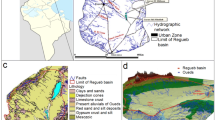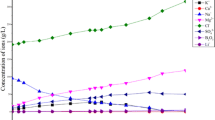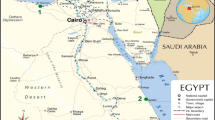Abstract
The salt assemblages precipitated during evaporation of concentrated brine collected from Gasikule Salt Lake (GSL) were studied to better understand the formation of potassium deposits in the Qaidam Basin. The study included isothermal evaporation at 25 °C in the laboratory and solar evaporation in the ponds at GSL field. Brines increased in density and became moderately acidic (pH ≈ 5.30) while major ion geochemistry and precipitate mineralogy all showed broad agreement between both systems. Four salt assemblages were identified in the isothermal evaporation experiment: halite → halite + hexahydrite → halite + bischofite + carnallite → bischofite. Alternately, three salt assemblages were recognized in the solar evaporation: halite → halite + epsomite + carnallite → halite + carnallite + bischofite. The key difference in salt assemblages between the two systems is attributed to differences in relative humidity and temperature conditions. Although the GSL has deep spring inflow recharge, the high abundance of MgSO4 salts demonstrates that the salt assemblages are similar to normal seawater evaporation. Thus, different proportions of deep spring inflow and river water could form both MgSO4-deficient potassium evaporite and normal seawater potassium evaporites. Therefore, nonmarine water may form diverse potassium evaporite deposits in continental basins when the geological structure as well as hydrogeological and climatic conditions is appropriate.
Similar content being viewed by others
References
Abdel Wahed MSM, Mohamed EA, El-Sayed MI, M’Nif A, Sillanpää M (2015) Crystallization sequence during evaporation of a high concentrated brine involving the system Na–K–Mg–Cl–SO4–H2O. Desalination 355:11–21. https://doi.org/10.1016/j.desal.2014.10.015
Casas E, Lowenstei TK, Spencer RJ, Zhang PX (1992) Carnallite mineralization in the nonmarine, Qaidam Basin, China: evidence for the early diagenetic origin of potash evaporites. SEPM J Sediment Res. https://doi.org/10.1306/d4267a05-2b26-11d7-8648000102c1865d
Chen KZ, Bowler JM (1986) Late pleistocene evolution of salt lakes in the Qaidam basin, Qinghai province, China. Palaeogeogr Palaeoclimatol 56:87–104
Chou IM, Seal RR (2003) Determination of epsomite-hexahydrite equilibria by the humidity-buffer technique at 0.1 MPa with implications for phase equilibria in the system MgSO4-H2O. Astrobiology 3:619–630. https://doi.org/10.1089/153110703322610708
Eastoe CJ, Peryt TM, Petrychenko OY, Geisler-Cussey D (2007) Stable chlorine isotopes in Phanerozoic evaporites. Appl Geochem 22:575–588. https://doi.org/10.1016/j.apgeochem.2006.12.012
Eugster HP (1980) Geochemistry of evaporitic lacustrine deposits. Annu Rev Earth Planet Sci 8:35–63
Eugster HP, Harvie CE, Weare JH (1980) Mineral equilibria in a six-component seawater system, Na–K–Mg–Ca–SO4–Cl–H2O, at 25°C. Geochim Cosmochim Acta 44:1335–1347
Fan Q, Ma Y, Cheng H, Wei H, Yuan Q, Qin Z, Shan F (2015) Boron occurrence in halite and boron isotope geochemistry of halite in the Qarhan Salt Lake, western China. Sediment Geol 322:34–42. https://doi.org/10.1016/j.sedgeo.2015.03.012
Fezei R, Hammi H, M’nif A (2009) Selective recovery of bischofite from Sebkha El Melah natural brine. Lat Am Appl Res 39:375–380
Fezei R, Hammi H, M’Nif A (2012) Extractive process for preparing high purity magnesium chloride hexahydrate. Chem Ind Chem Eng Q 18:83–88. https://doi.org/10.2298/Ciceq110815049f
Gao F, Zheng M, Song P, Bu L, Wang Y (2012) The 273.15-K-isothermal evaporation experiment of lithium brine from the Zhabei Salt Lake, Tibet, and its geochemical significance. Aquat Geochem 18:343–356. https://doi.org/10.1007/s10498-012-9168-1
Hardie LA (1990) The roles of rifting and hydrothermal CaCl2 brines in the origin of potash evaporites: an hypothesis. Am J Sci 290:43–106
Hardie LA, Eugster HP (1970) The evolution of closed-basin brines. Mineral Soc Am Spec 3:273–290
(JCPDS) JCoPDS (1980) Powder diffraction file search manual, inorganic phases 1980. International Centre for Diffraction Data, Swartmore
Jambor JL, Nordstrom DK, Alpers CN (2000) Metal-sulfate salts from sulfide mineral oxidation. Rev Mineral Geochem 40:302–350
Jensen GKS, Rostron BJ, Duke MJM, Holmden C (2006) Bromine and stable isotopic profiles of formation waters from potash mine-shafts, Saskatchewan, Canada. J Geochem Explor 89:170–173. https://doi.org/10.1016/j.gexplo.2005.11.071
Keller LP, Mccarthy GJ, Richardson JL (1986a) Laboratory modeling of northern great plains salt efflorescence mineralogy. Soil Sci Soc Am J 50:1363–1367
Keller LP, Mccarthy GJ, Richardson JL (1986b) Mineralogy and stability of soil evaporites in North Dakota. Soil Sci Soc Am J 50:1069–1071
Keys JR, Williams K (1981) Origin of crystalline, cold desert salts in the McMurdo region, Antarctica. Geochim Cosmochim Acta 45:2299–2309
Kilic O, Kilic AM (2006) Recovery of salt co-products during the salt production from brine. Desalination 186:11–19. https://doi.org/10.1016/j.desal.2005.05.014
Kong WG, Zheng MP, Kong FJ, Chen WX (2014) Sulfate-bearing deposits at Dalangtan Playa and their implication for the formation and preservation of martian salts. Am Mineral 99:283–290. https://doi.org/10.2138/am.2014.4594
Lowenstein TK, Risacher F (2008) Closed basin brine evolution and the influence of Ca–Cl inflow waters: death Valley and Bristol Dry Lake California, Qaidam Basin, China, and Salar de Atacama, Chile. Aquat Geochem 15:71–94. https://doi.org/10.1007/s10498-008-9046-z
Lowenstein TK, Spencer RJ, Zhang PX (1989) Origin of ancient potash evaporites clues from the modem nonmarine Qaidam Basin of western China. Science 245:1090–1092
McCaffrey MA, Lazar B, Holland HD (1987) The evaporation path of seawater and the coprecipitation of Br− and K+ with halite. J Sediment Petrol 57:928–937
Pedley A, Neubert J, van der Klauw S (2016) Potash deposits in Africa introduction, potash deposits of the Republic of Congo, and other African potash deposits and occurrences. Episodes 39:447–457. https://doi.org/10.18814/epiugs/2016/v39i2/95787
Skarie RL, Richardson JL, Mccarthy GJ, Maianu A (1987) Evaporite mineralogy and groundwater chemistry associated with saline soils in eastern North Dakota. Soil Sci Soc Am J 51:1372–1377
Spencer RJ, Lowenstein TK, Casas E, Zhang PX (1990) Origin of potash salts and brines in the Qaidam Basin, China. Fluid Mineral Interact 2:395–408 (a tribute to Hans Eugster The Geochemical Society Special Publications)
Steiger M, Linnow K (2008) Hydration of MgSO4 ·H2O and generation of stress in porous materials. Cryst Growth Des 8:336–343
Sun D, Li B, Ma Y, Liu Q (2002) An investigation on evaporating experiments for Qinghai lake water, China. J Salt Lake Res 10:1–12
Tait AW, Wilson SA, Tomkins AG, Gagen EJ, Fallon SJ, Southam G (2017) Evaluation of meteorites as habitats for terrestrial microorganisms: results from the Nullarbor Plain, Australia, a Mars analogue site. Geochim Cosmochim Acta 215:1–16. https://doi.org/10.1016/j.gca.2017.07.025
Timofeeff MN, Lowenstein TK, da Silva MA, Harris NB (2006) Secular variation in the major-ion chemistry of seawater: evidence from fluid inclusions in Cretaceous halites. Geochim Cosmochim Acta 70:1977–1994. https://doi.org/10.1016/j.gca.2006.01.020
Vaniman DT, Bish DL, Chipera SJ, Fialips CI, Carey JW, Feldman WC (2004) Magnesium sulphate salts and the history of water on Mars. Nature 431:663–665
Wang J, Fang X, Appel E, Zhang W (2013) Magnetostratigraphic and radiometric constraints on salt formation in the Qaidam Basin, NE Tibetan Plateau. Quatern Sci Rev 78:53–64. https://doi.org/10.1016/j.quascirev.2013.07.017
Wang L, Liu C, Gao X, Zhang H (2014a) Provenance and paleogeography of the Late Cretaceous Mengyejing Formation, Simao Basin, southeastern Tibetan Plateau: whole-rock geochemistry, U–Pb geochronology, and Hf isotopic constraints. Sediment Geol 304:44–58. https://doi.org/10.1016/j.sedgeo.2014.02.003
Wang X, Miller JD, Cheng F, Cheng H (2014b) Potash flotation practice for carnallite resources in the Qinghai Province, PRC. Miner Eng 66–68:33–39. https://doi.org/10.1016/j.mineng.2014.04.012
Wang A, Jolliff BL, Liu Y, Connor K (2016) Setting constraints on the nature and origin of the two major hydrous sulfates on Mars: monohydrated and polyhydrated sulfates. J Geophys Res Planets 121:678–694. https://doi.org/10.1002/2015je004889
Warren JK (2016) Evaporites a geological compendium, 2nd edn. Springer, Berlin. https://doi.org/10.1007/978-3-319-13512-0
Ye C, Zheng M, Wang Z, Hao W, Wang J, Lin X, Han J (2015) Hydrochemical characteristics and sources of brines in the Gasikule salt lake, Northwest Qaidam Basin, China. Geochem J 49:481–494. https://doi.org/10.2343/geochemj.2.0372
Zayani L, Rokbani R, Trabelsi-Ayadi M (1999) Study of the evaporation of a brine involving the system Na+, Mg2+, K+, Cl−, SO4 2−–H2O crystallisation of oceanic salts. J Therm Anal Calorim 57:575–585
Zhang PX (1987) Salt lakes in the Qaidam Basin. Publishing House of Science, Beijing
Zhang PX, Zhang BZ, Lowenstein TK, Pancer RJ (1993) Origin of ancient potash evaporites: examples from the formation of potash of Qarhan Salt Lake in Qaidam Basin. Science Press, Beijing
Zhang X et al (2015) Late Cretaceous potash evaporites in Savannakhet Basin of middle Laos: geochemical evidences of non-marine inputs. Acta Pet Sin 31:2783–2793
Zhang X, Meng F, Li W, Tang Q, Ni P (2016) Reconstruction of Late Cretaceous coastal paleotemperature from halite deposits of the Late Cretaceous Nongbok Formation (Khorat Plateau, Laos). Palaeoworld 25:425–430. https://doi.org/10.1016/j.palwor.2015.11.004
Zhang H, Lu F, Mischke S, Fan M, Zhang F, Liu C (2017) Halite fluid inclusions and the late Aptian sea surface temperatures of the Congo Basin, northern South Atlantic Ocean. Cretac Res 71:85–95. https://doi.org/10.1016/j.cretres.2016.11.008
Zheng M (2011) Resources and eco-environmental protection of salt lakes in China. Environ Earth Sci 64:1537–1546. https://doi.org/10.1007/s12665-010-0601-8
Zheng MP, Liu XF (2009) Hydrochemistry of salt lakes of the Qinghai-Tibet Plateau, China. Aquat Geochem 15:293–320. https://doi.org/10.1007/s10498-008-9055-y
Acknowledgements
We are grateful to Prof. Z. M. Wang, vice Prof. W. L. Hao, J. Han and X. B. Lin from the Beijing Research Institute of Uranium Geology and vice Prof. J. X. Xu, Doctor T. W. Li, Doctor X. L. Yuan, and Doctor W. L. Miao from the Institute of Salt Lakes, Chinese Academy of Sciences, for their assistance in the field sampling. This research was supported jointly by the National Natural Science Foundation of China (Grant Nos. 41603048, 41473061 and U1407207) and China Geological Survey (Grant Nos. DD20160025 and DD20160054). The manuscript benefited from the insightful review from an anonymous reviewer.
Author information
Authors and Affiliations
Corresponding author
Rights and permissions
About this article
Cite this article
Ye, C., Mao, J., Ren, Y. et al. Salt Crystallization Sequences of Nonmarine Brine and Their Application for the Formation of Potassium Deposits. Aquat Geochem 24, 209–229 (2018). https://doi.org/10.1007/s10498-018-9340-3
Received:
Accepted:
Published:
Issue Date:
DOI: https://doi.org/10.1007/s10498-018-9340-3












